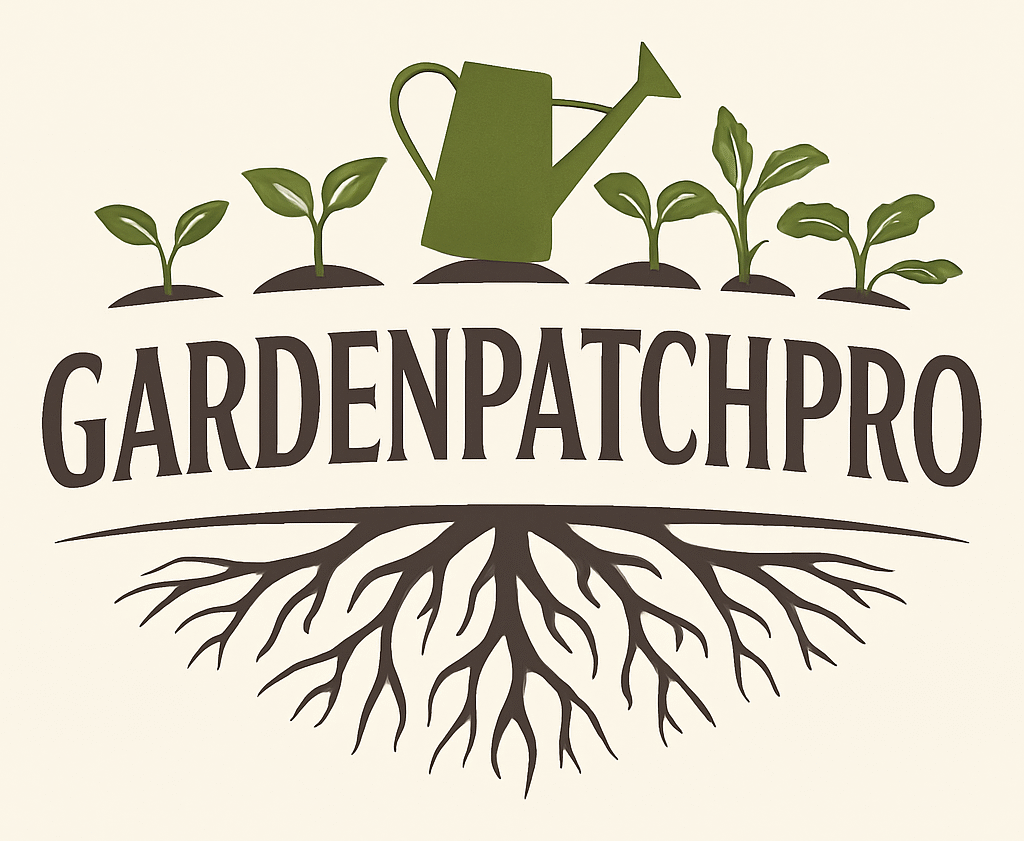12 Herbs Garden Ideas for Year-Round Freshness and Easy Maintenance
Growing herbs at home is a simple way to add fresh flavors to meals and promote healthier eating. Many people want to create their own herb gardens but may not know where to start or how to use limited space effectively.
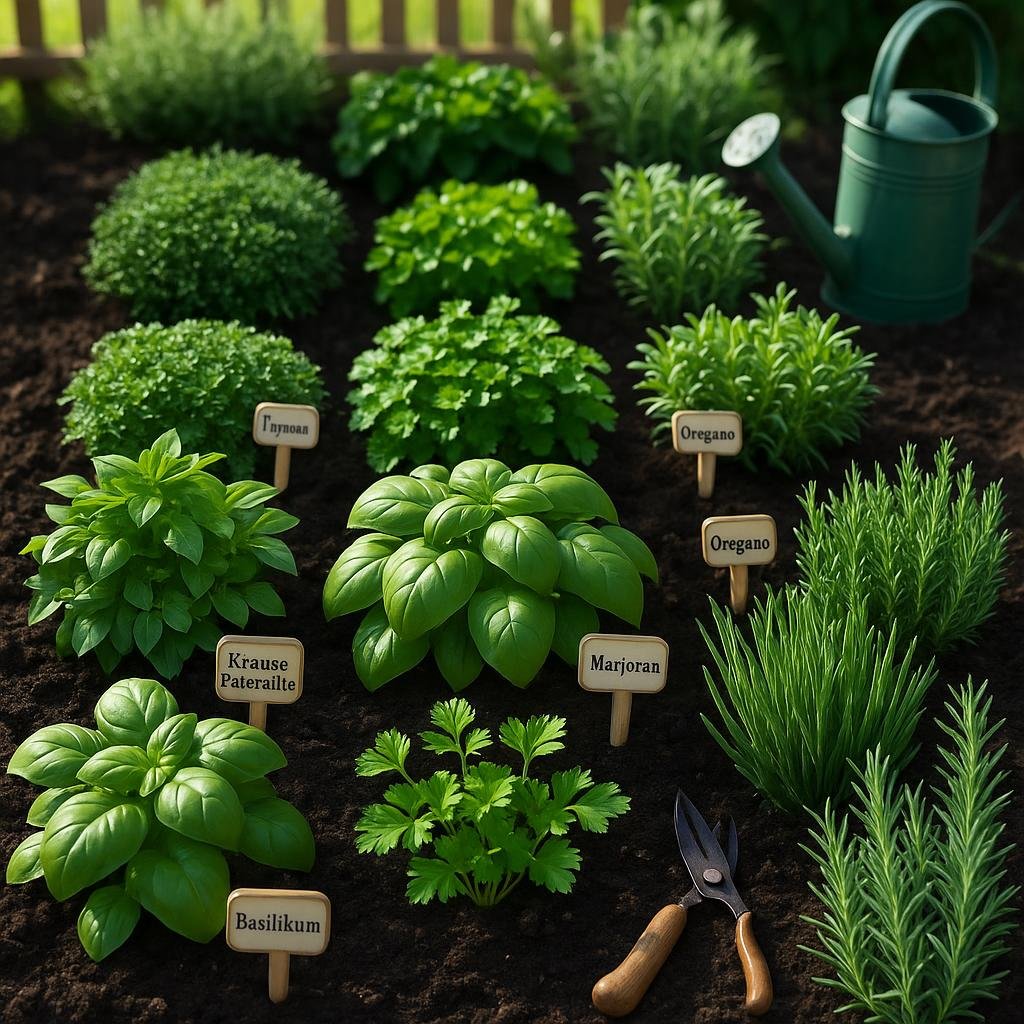
This article shares 12 practical herb garden ideas to help people grow herbs successfully, whether indoors or outdoors. These ideas can suit different spaces and skill levels, making it easier for anyone to enjoy fresh herbs year-round.
1) Raised Bed Herb Garden
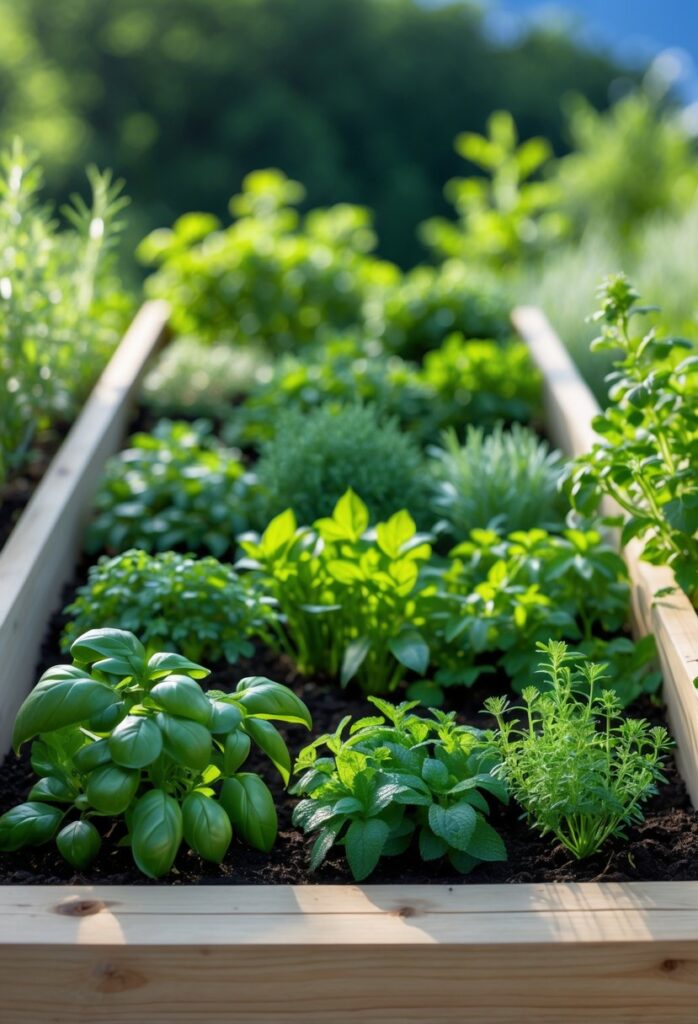
A raised bed herb garden is a practical way to grow herbs. It helps keep soil well-drained and prevents herbs from sitting in wet ground. This method also makes it easier to control the soil quality and nutrients.
Using wooden frames or other materials, raised beds create organized sections for different herbs. This helps keep the garden tidy and makes care and harvest simple.
Raised beds are ideal for small spaces and can be placed near a kitchen for easy access. They work well for a variety of herbs like basil, rosemary, thyme, and mint.
This setup also reduces weed growth and can protect plants from pests. Gardeners can adjust the bed height for comfort, which is helpful for those who prefer not to bend down.
For more ideas and tips on raised bed herb gardens, see this guide on growing herbs in raised beds.
2) Vertical Wall Planters
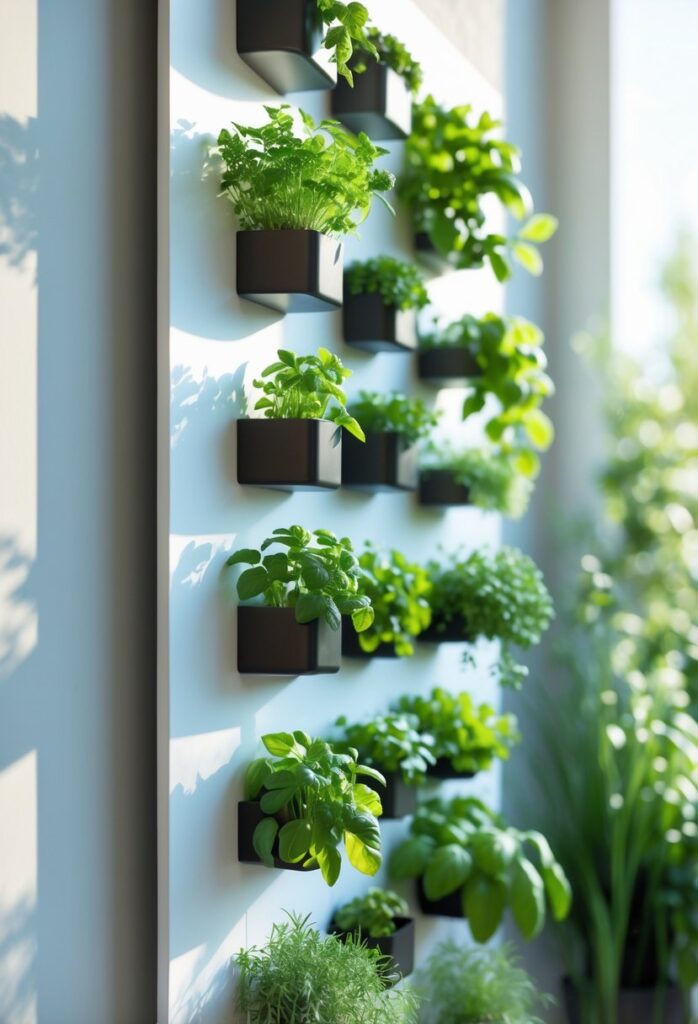
Vertical wall planters use wall space to grow herbs, making them perfect for small areas. They can be mounted on fences, walls, or balconies, saving floor space while keeping herbs easy to reach.
These planters come in many styles, such as pockets, shelves, or mounted pots. Using bright pots or colorful containers can add visual interest to any space.
Wall planters help improve air circulation around herbs, reducing the chance of diseases. They also make it easier to care for plants by organizing them neatly.
Many vertical wall planters are simple to build or buy. Some use fabric pockets or recycled materials to hold soil and plants. This makes them practical and eco-friendly.
Herbs like basil, mint, thyme, and rosemary grow well in vertical wall gardens. They allow fresh herbs to be close at hand for cooking and garnish.
For more ideas on creating these setups, see creative options for vertical herb gardens.
3) Spiral Herb Garden Design

A spiral herb garden uses a raised, circular design that winds upward in a spiral shape. This layout helps save space by growing many herbs vertically rather than spreading them out flat. It also creates different levels of moisture and sunlight for a variety of herbs.
Herbs that like dry soil, such as rosemary, are placed near the top. Plants needing more water, like mint or basil, grow near the bottom where the soil stays moist. This natural drainage supports healthy growth for all plants.
The spiral design also makes it easier to care for herbs. It keeps them organized and accessible without taking up much garden space. The structure encourages good air circulation, which reduces the chances of mold or pests.
Building an herb spiral involves stacking soil and stones to create the spiral shape. People can customize designs with natural materials like stone or wood for stability and style. It’s a practical method that turns a small area into a diverse herb garden.
For more ideas and tips, see this guide on spiral herb garden design, plants, and plans.
4) Herb Garden Window Boxes

Herb garden window boxes offer a practical way to grow fresh herbs in small spaces. They are ideal for apartments or homes without a yard. Window boxes fit easily on windowsills or balconies, bringing greenery close to the kitchen.
These boxes allow herbs to get plenty of sunlight. They also provide good drainage, which many herbs need to stay healthy. Because they are portable, gardeners can move them to follow the sun throughout the day.
Choosing the right herbs is important. Many herbs like basil, parsley, thyme, and chives grow well in window boxes. These herbs don’t take up much space and can be harvested regularly for cooking.
Window boxes add color and aroma to a home, making the kitchen area more inviting. They are also easy to maintain with regular watering and occasional feeding. Growing herbs in window boxes is a simple way to have fresh ingredients ready at hand.
For more tips on planting and selecting herbs for window boxes, visit 12 Best Window Box Herbs to Grow.
5) Balcony Container Herb Garden
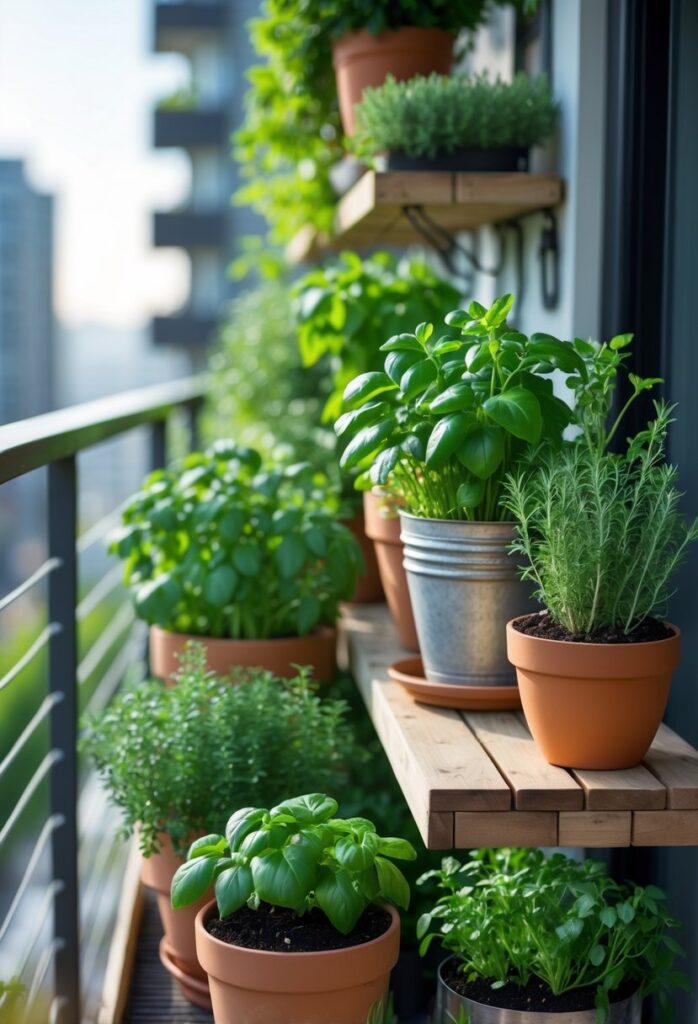
A balcony container herb garden is a practical way to grow fresh herbs in a small space. It uses pots or containers that fit well on railings, shelves, or the floor.
Containers come in many shapes and sizes. Choosing the right size helps herbs grow healthy roots without taking up too much room. Drainage holes are important to keep soil from getting too wet.
Many herbs do well in containers, such as basil, mint, rosemary, and thyme. They need regular sunlight, usually at least 4 to 6 hours a day, to thrive.
This type of garden is easy to maintain. It requires watering, occasional feeding with fertilizer, and pruning to keep plants producing leaves.
Using vertical shelves or railing planters can maximize space. This lets gardeners grow more herbs without crowding the balcony.
For practical tips and container ideas, a guide on balcony herb garden ideas offers many useful suggestions.
6) Indoor Kitchen Herb Garden

An indoor kitchen herb garden lets people grow fresh herbs all year round. It works well for those with limited outdoor space or busy schedules. Herbs like basil, thyme, and cilantro grow easily indoors with proper care.
Placing the herb garden near a sunny window helps plants get enough light. If natural light is limited, using a small grow light can support healthy growth. Choosing the right containers is important to keep the herbs healthy and organized.
Vertical planters or small pots on windowsills save counter space. Some use hydroponic systems or hanging planters to maximize room. Regular watering and proper drainage prevent overwatering and root problems.
Having fresh herbs close by encourages cooking with real flavors. This setup can bring a touch of nature into the kitchen while providing herbs for seasoning. For more ideas on setting up an indoor herb garden, one can explore creative options for their specific space and light conditions. Visit 15 creative indoor herb garden ideas for more details.
7) Vertical Pallet Herb Garden
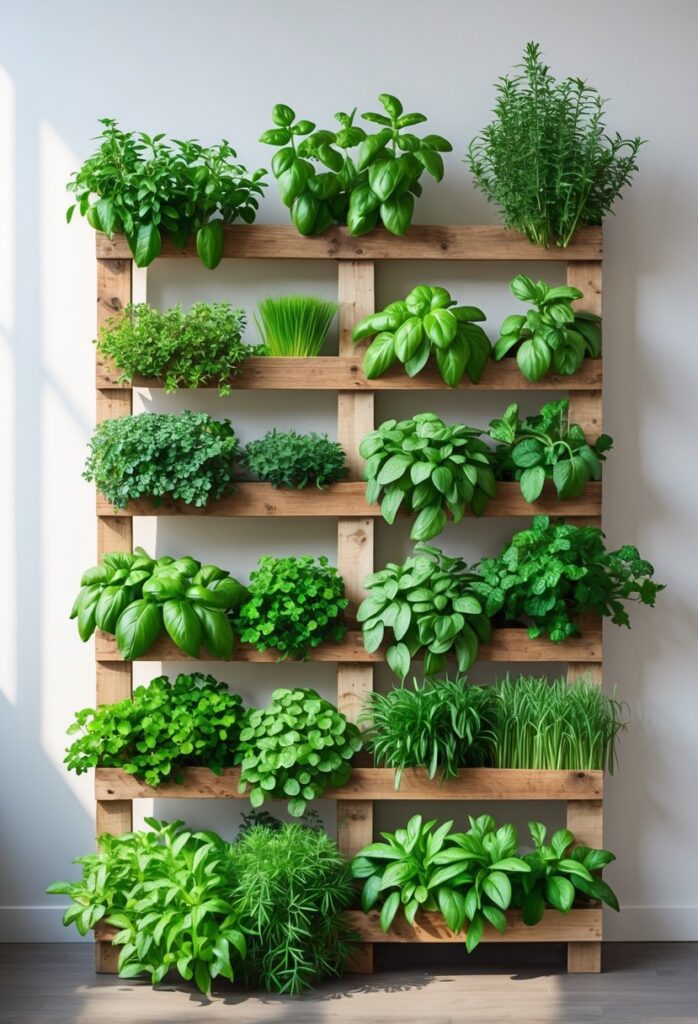
A vertical pallet herb garden uses wooden pallets to create a space-saving structure for growing herbs. By standing a pallet upright, plants can be placed between the slats or in attached pots. This design makes good use of wall or balcony space.
Herbs like basil, thyme, mint, and parsley grow well in this setup. The vertical layout allows for easy access to fresh herbs while keeping them organized in a small area.
The pallet can be painted or stained to fit outdoor or indoor decor. Labeling each section helps identify the herbs quickly. This method also doubles the planting space by stacking or layering pallets if needed.
Materials for this project include sturdy pallets, small pots or planter boxes, and fasteners to secure plants. It is a simple, affordable way to add greenery and fresh herbs to limited spaces. For more ideas on this method, see a detailed vertical pallet herb garden guide.
8) Companion Planting for Herbs

Companion planting helps herbs grow better by pairing plants that support each other. Some herbs improve soil health, attract helpful insects, or keep pests away. This method can lead to a healthier, more productive garden.
Certain herbs, like basil and parsley, do well when planted together. Others, such as fennel, should be kept separate because they release chemicals that stunt growth in nearby plants. Knowing which herbs to plant side by side is key.
Companion planting also saves space. Gardeners can grow more plants in smaller areas by choosing compatible herbs. It works well in both ground gardens and containers.
Choosing proper pairs makes gardening easier and can enhance the flavors of herbs used in cooking. For more detailed advice, refer to this herb companion planting chart and other guides that list best combinations and avoidances.
9) Spice-Themed Herb Garden
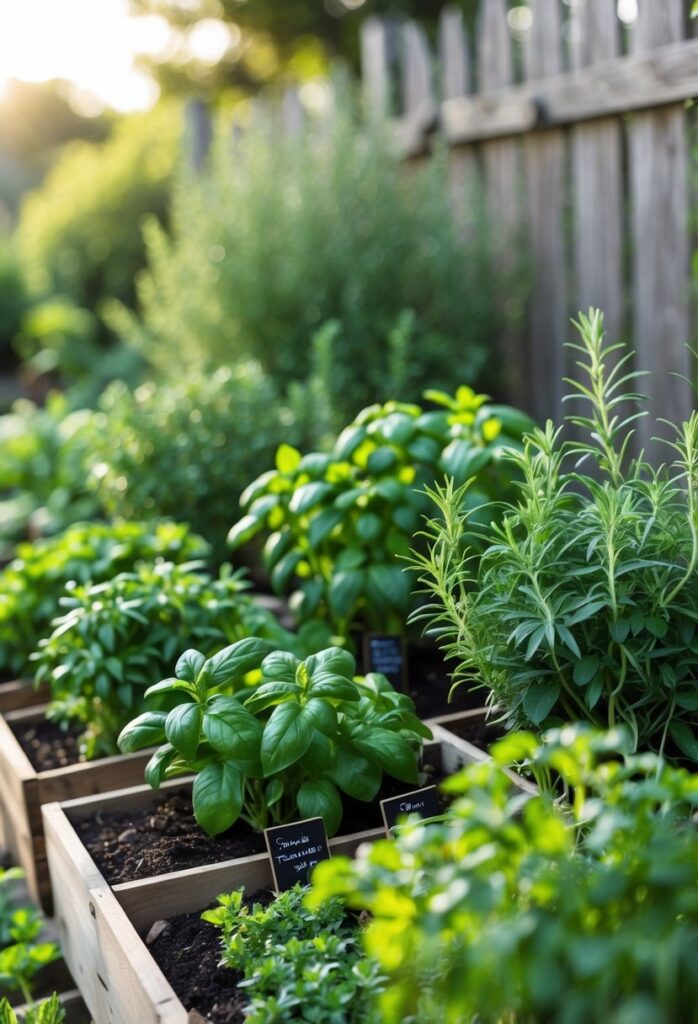
A spice-themed herb garden focuses on growing herbs known for their strong flavors and aroma. Common choices include basil, rosemary, thyme, and oregano. These herbs add bold tastes to many dishes.
This garden idea groups spices based on their culinary use. It helps gardeners easily pick herbs for cooking. It also creates a dedicated space that highlights the kitchen’s most useful flavors.
Plants like sage and mint fit well in this setup. Their unique scents and tastes complement other spices. Growing them together maximizes the garden’s variety without needing much extra space.
Using a spice-themed herb garden can improve meal preparation. Fresh herbs provide stronger flavors than dried ones. This setup can fit small patios or larger garden beds.
For more design ideas and tips on grouping herbs by use, see the 14+ Stunning Herb Garden Layout Ideas page.
10) Herb Garden with Trellises

Using trellises in an herb garden helps save space by allowing plants to grow vertically. This is especially useful in small gardens or areas with limited ground space. Trellises also keep herbs organized and easy to reach.
There are many types of trellises, such as wooden frames, metal pipes, or even repurposed materials. Gardeners can choose a style that fits their space and design. Vertical trellises support climbing herbs like thyme, oregano, and certain mints.
A well-planned trellis setup can improve air circulation around plants. This reduces the risk of disease and encourages healthy growth. Trellises can also add a decorative element to the garden, making it both functional and attractive.
For ideas on how to build or arrange trellises in an herb garden, see examples of herb garden trellis ideas that combine practicality and style.
11) DIY Mason Jar Herb Planters

DIY mason jar herb planters are a simple way to grow fresh herbs indoors. They take up little space and fit well on kitchen windowsills or shelves. This makes it easy to have herbs handy while cooking.
People can use mason jars of different sizes based on the type of herb and space available. The jars should have good drainage, which can be done by adding small stones or gravel at the bottom.
This project is quick to start and does not need special tools. It is also a sustainable option since mason jars are reusable.
Mason jar herb planters bring a rustic look to any room and make fresh herbs accessible. They can be hung or placed on a flat surface, fitting various home styles.
More detailed guides can be found on how to build a mason jar herb garden at home. This helps beginners care for their plants properly and enjoy their harvest easily.
Learn more about creating these planters in a DIY Mason Jar Herb Garden.
12) Square Foot Herb Garden Layout
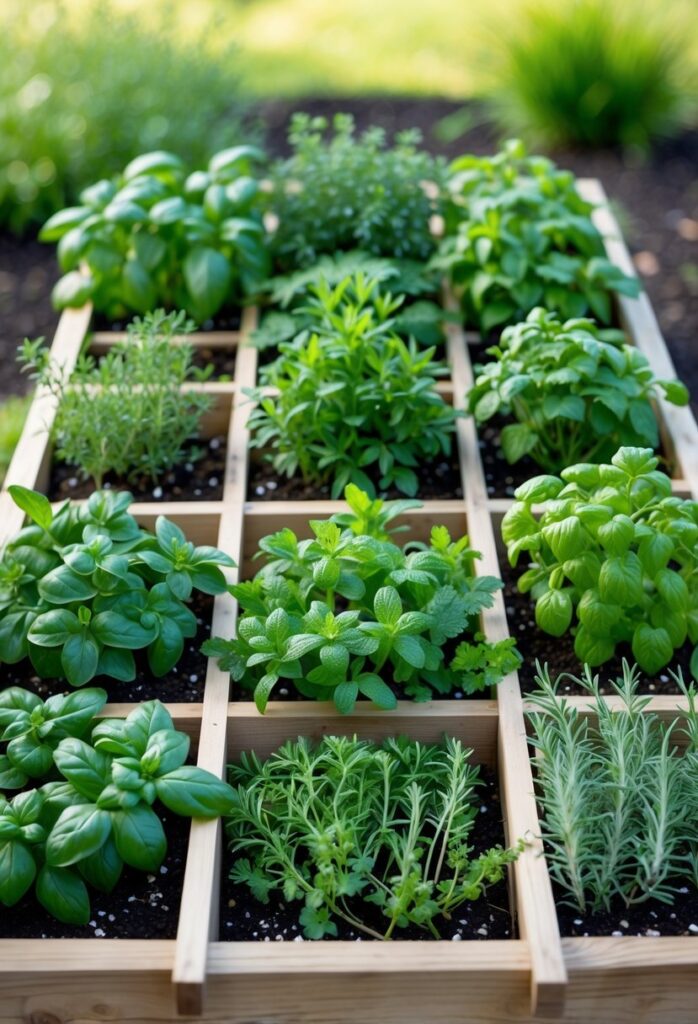
The square foot herb garden layout is a practical way to grow many herbs in a small space. It divides a raised bed into equal squares, each dedicated to a specific herb. This helps keep the garden organized and easy to manage.
Each square typically measures one foot by one foot. Gardeners can plant different herbs based on their growth needs and space requirements. This method suits patios, balconies, or small yards well.
It allows for efficient use of space while keeping plants close enough for easy care. The layout supports a variety of herbs, from basil and thyme to parsley and chives. It is especially helpful for beginners learning how to manage a garden.
Using this layout, herbs that need similar sunlight or water can be grouped together. This makes watering and harvesting more convenient. Square foot gardening is known for its simplicity and neat appearance.
More ideas for smart and efficient planting can be found in detailed square-foot garden layout guides.
Choosing the Right Spot for Your Herb Garden
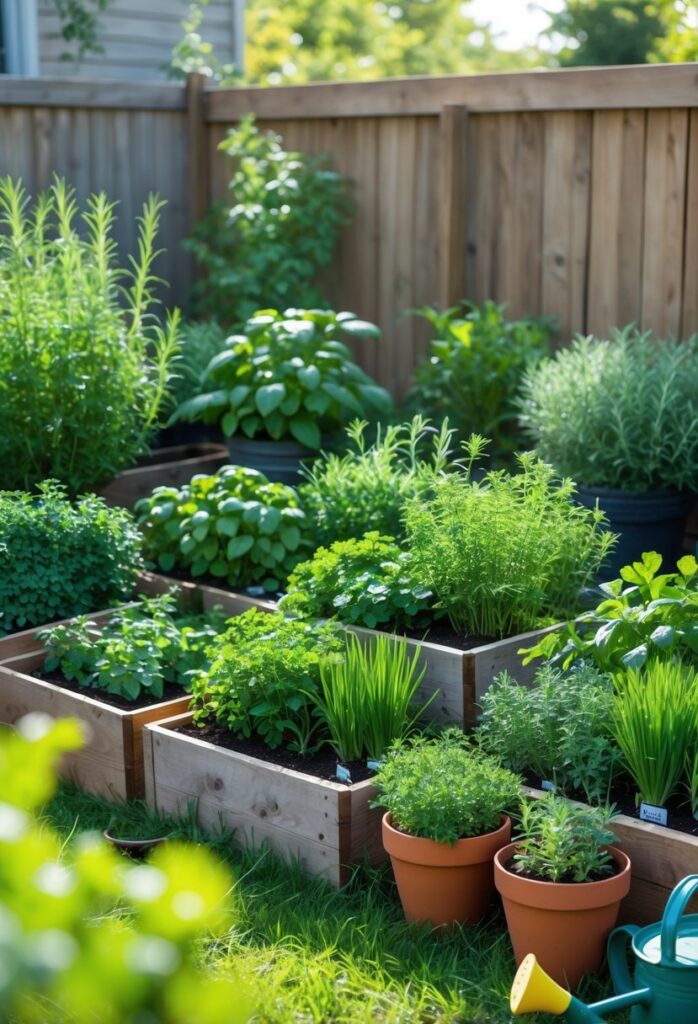
Selecting the perfect place for an herb garden depends mainly on sunlight, soil, and whether to plant directly in the ground or containers. These factors influence how your herbs grow, their flavor, and how easy they are to care for.
Sunlight and Soil Considerations
Most herbs need plenty of sunlight—about 6 to 8 hours a day. A spot with full sun helps herbs like basil, rosemary, and thyme thrive. If the location is shady, herbs may grow weak or lose flavor.
The soil should drain well to avoid waterlogging. Herbs prefer soil that is light and moderately fertile. Heavy clay or constantly wet soil can harm roots. Amending the soil with compost improves drainage and adds nutrients. Testing soil for pH is helpful because most herbs like slightly acidic to neutral soil (pH 6-7).
Choosing a location near a water source saves time during watering. The area should also have good air circulation to reduce disease risk.
Container vs. In-Ground Options
Herbs can be grown in pots or directly in garden soil. Containers offer flexibility; they can be moved to catch more sun or shelter from harsh weather. This is ideal for balconies, small spaces, or areas with poor soil.
In-ground planting allows roots more space to grow, which some herbs like parsley and chives prefer. It often requires less watering because soil retains moisture better. However, in-ground gardens need well-prepared soil and space free from weeds.
Containers require regular watering and nutrient replenishment. Using a soil mix designed for herbs helps maintain proper moisture and nutrients. Raised garden beds combine benefits of both, offering good drainage and room for roots, while simplifying maintenance.
For more on ideal garden spots, see this guide on choosing the perfect location for your herb garden.
Design Tips for a Thriving Herb Garden
Successful herb gardens need careful planning about what grows well together and the way the garden looks. Both plant compatibility and visual appeal play key roles in a strong, healthy herb garden.
Companion Planting Strategies
Companion planting helps herbs grow better by pairing plants that support each other. For example, basil planted near tomatoes can improve growth and reduce pests. Avoid planting herbs like sage and rosemary close to mint, since mint spreads fast and can crowd other plants.
Grouping herbs by their water and sunlight needs keeps them healthy. Mediterranean herbs like thyme and lavender prefer dry, sunny spots, while parsley and mint like more moisture and shade. Using raised beds or containers can help manage these differences.
Regularly rotating plants helps prevent diseases and soil depletion. Knowing which herbs protect each other from pests reduces the need for chemicals, improving garden health naturally.
Incorporating Aesthetic Elements
An herb garden should be both useful and visually pleasing. Using raised wooden beds or stone borders can create clean lines and organize the space. Adding vertical structures, like trellises, makes use of height and adds dimension.
Choosing a variety of leaf colors and textures adds visual interest. For example, mix the soft gray-green leaves of lavender with the bright green of basil and the deep purple of purple basil.
Paths or stepping stones allow easy access for harvesting without compacting the soil. Using attractive containers or themed garden sections—such as a tea herb corner with mint, chamomile, and lemon balm—adds charm and focus to the space. For more ideas, visit stunning herb garden layout ideas.
Frequently Asked Questions
Many herb garden ideas focus on maximizing space, selecting the right plant combinations, and using simple methods to start and maintain a healthy garden. Understanding these details helps create a functional and attractive herb garden.
What are some creative outdoor herb garden layouts?
Gardeners often use raised beds, vertical wall planters, or spiral garden designs to save space and add interest. These layouts improve access to plants and help with drainage and soil control. Window boxes and balcony containers are also popular choices for small outdoor areas.
How can you design an efficient indoor herb garden for limited spaces?
Using vertical planters or window boxes helps maximize light and space indoors. A compact design with herbs placed in containers that fit on shelves or kitchen counters makes care easier. Good lighting and proper drainage are key for an efficient setup.
Which pairs of herbs are known to grow well together?
Companion planting is important for plant health. Basil and tomatoes thrive near each other. Rosemary pairs well with sage and thyme, while parsley and chives can grow side by side without issues. Avoid planting herbs that require very different water or light levels together.
What essential herbs should be included in a beginner’s herb garden?
Common beginner herbs include basil, mint, parsley, thyme, rosemary, and chives. These plants are hardy, need moderate care, and are useful in many recipes. Most require good sunlight and well-drained soil to thrive.
Can you suggest some DIY methods for starting an herb garden?
Starting with small containers or repurposed items like wooden boxes works well. Gardeners can build raised beds or create vertical planters with pallets or shelves. Seeds or young plants from nurseries are both good starting points.
What are the best ways to maintain a beautiful and thriving herb garden?
Regular watering without overwatering is crucial. Pruning keeps herbs healthy and encourages growth. Using quality soil, checking for pests, and providing enough sunlight all help maintain a vibrant garden. Adding mulch can retain moisture and reduce weeds.
For more ideas on layouts and planting tips, see creative outdoor herb garden options.
